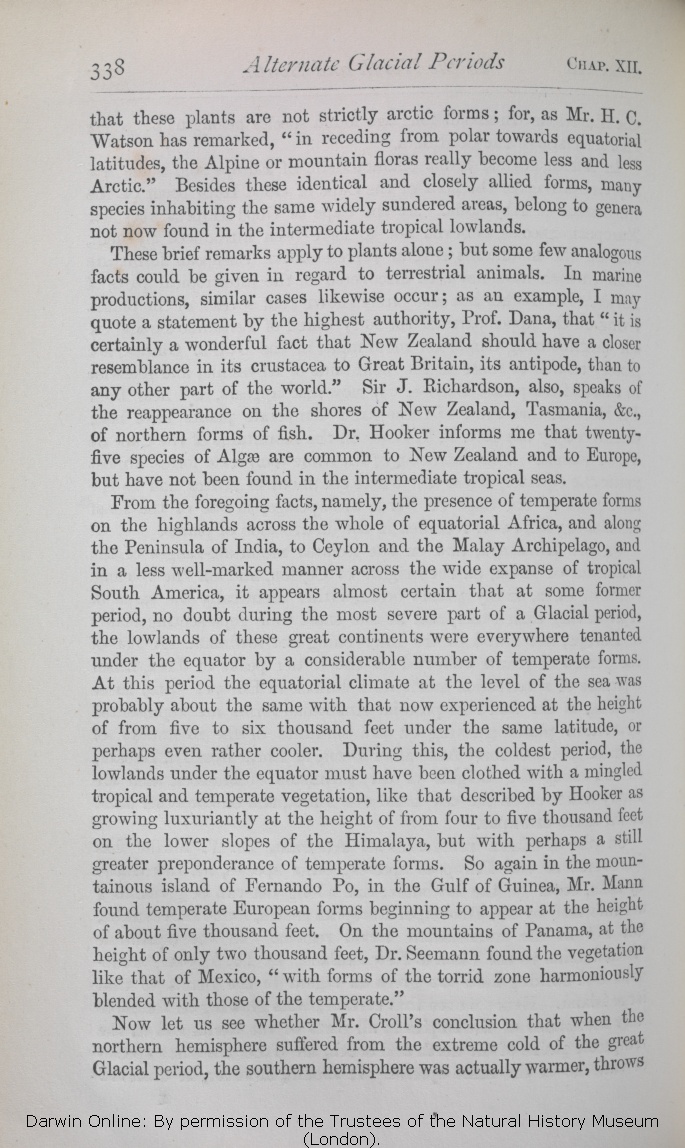|
that these plants are not strictly
arctic
forms; for, as Mr. H. C. Watson has remarked, "in receding from polar towards equatorial latitudes, the Alpine or mountain floras really become less and less Arctic." Besides these identical and closely allied forms, many species inhabiting the same widely sundered areas, belong to genera not now found in the intermediate tropical lowlands. |
|
These | These 1869 1872 | | This 1859 1860 1861 1866 |
| remarks apply 1869 1872 | | abstract applies 1859 1860 1861 1866 |
| alone; 1869 1872 | | alone: 1859 1860 1861 1866 |
| but some few 1869 1872 |
| some strictly 1859 1860 1861 1866 |
| in regard to 1869 1872 |
| on the distribution of 1859 1860 1861 1866 |
| likewise occur; 1869 1872 | | occur; 1859 1860 1861 1866 |
| statement 1869 1872 | | remark 1859 1860 1861 1866 |
| "it 1859 1860 1866 1869 1872 | | "it 1861 |
| world." 1859 1860 1866 1869 1872 | | world." 1861 |
| &c., 1859 1860 1866 1869 1872 | | &c, 1861 |
|
|
From the foregoing facts,
namely,
the presence of temperate forms on the highlands across the whole of equatorial Africa, and along the Peninsula of
India,
to Ceylon and the Malay
Archipelago, | Archipelago, 1872 | | archipelago, 1869 |
| latitude, 1872 | | latitudes, 1869 |
| 3 blocks not present in 1869 1872; present in 1859 1860 1861 1866 | | It should be observed that the northern species and
forms found in
the southern parts
of the southern hemisphere, and on the mountain-ranges of the
intertropical regions,
are not arctic, but belong to
the northern
temperate
zones.
As
Mr. H. C. Watson has recently remarked, "In
receding from polar towards equatorial latitudes, the Alpine or mountain floras really become less and less arctic."
Many of the forms living on the mountains of the warmer regions of the earth and in the southern hemisphere are of doubtful value, being
ranked by some
naturalists as specifically distinct, by others as varieties; but some are certainly identical, and many, though closely related to northern forms, must be ranked as distinct species.
|
|
|
Now let us see
whether Mr. Croll's conclusion that when the northern hemisphere suffered from the extreme cold of the great Glacial period, the southern hemisphere was actually warmer, throws any clear light | whether Mr. Croll's conclusion that when the northern hemisphere suffered from the extreme cold of the great Glacial period, the southern hemisphere was actually warmer, throws any clear light 1872 |
| what light can be thrown 1859 1860 1861 1866 |
| whether Mr. Crolls conclusion that when the northern hemisphere suffered from the extreme cold of the great Glacial period, the southern hemisphere was actually warmer, throws any clear light 1869 |
| present apparently inexplicable distribution of various organisms in the temperate parts of both hemispheres, and on the mountains of the tropics. 1872 |
| foregoing facts, on the belief, supported as it is by a large body of geological evidence, that the whole world, or a large part of it, was during the Glacial period simulta- neously much colder than at present. 1859 |
| foregoing facts, on the belief, supported as it is by a large body of geological evidence, that the whole world, or a large part of it, was during the Glacial period simultaneously much colder than at present. 1860 1861 |
| foregoing facts, on the belief, supported as it is by a large body of geological evidence, that the whole world, or a large part of it, was simultaneously colder during the Glacial period than at present. 1866 |
| present apparently inexplicable distribution of various organisms in the temperate parts of both hemispheres, and on mountains of the tropics. 1869 |
|









